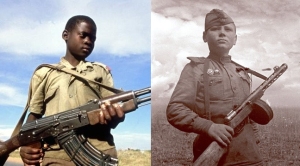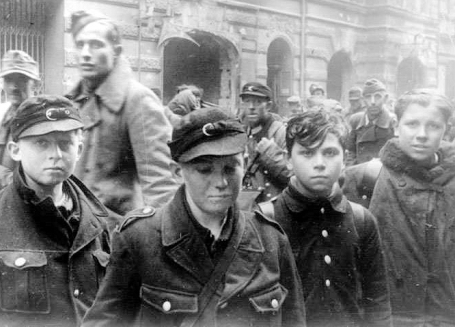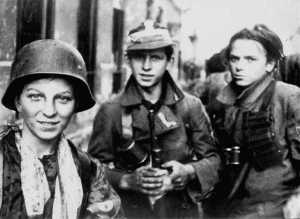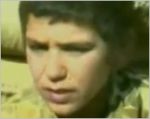President Abraham Lincoln had recently signed the act of Congress creating the Medal of Honor. Secretary of War William Stanton personally awarded the first medals. On September 16, 1863, it was received by Willie Johnston, He was 13 years old and only 5 feet tall. He had enlisted in the army at the age of 11, and was awarded the highest medal for his bravery during the Peninsula Campaign when he was 12.
Most of us have been shocked by the documentation of Child Soldiers with modern automatic weapons fighting in some of the most bitter and brutal wars on our planet. The notion that children, who by the legal and ethical standards of our society, could not be held responsible for a crime because of their immaturity, are put in a situation of killing hundreds of fellow humans and making all the moral and ethical decisions we expect soldiers in war to make is very had to digest. People are shocked, and also ask how did this happen? What can be done to prevent it?
However, the photographs below give us a historical picture that is surprising to many of us. The left hand child soldier is typical of what we have seen in the Western media for a few years now. The Lord’s Resistance Army of Uganda was prototypical of large parts of Africa, Asia, and some of the Arab nations of the Middle East.
The picture to the right–the other young b oy with the latest automatic weapon of the time was a Russian boy who fought Germany in WWII.
oy with the latest automatic weapon of the time was a Russian boy who fought Germany in WWII.
 oy with the latest automatic weapon of the time was a Russian boy who fought Germany in WWII.
oy with the latest automatic weapon of the time was a Russian boy who fought Germany in WWII.
However an inquiry into the history of child soldiers provides us with a reality that most of us do not welcome. Child soldiers have been the norm throughout history and have been accepted in almost all societies until relatively recently.
So many of American norms and perceptions of war have been formed by World War I and II, that we tend to perceive our behavior in these wars as normal and other wars as aberrant. Perhaps, it was those wars that were the unusual ones and the others more typical.
During the two World Wars, the United States had formal age requirements for military service. There were instances where these regulations were evaded by youngsters lying about their age, but these were not very frequent. The American armed forces in the two World Wars was composed of young men, 17 and over with a strong representation of middle-aged men 30-40, This however was not the case for our other nations.

These German children were captured soldiers who had been fighting fiercely.
The Germans equipped an entire SS Panzer Tank Division and manned it with 16 and 17-year-old boys from the Hitler Youth brigades. As Germany suffered more casualties, more teenagers volunteered and were accepted, initially as reserve troops but then as regulars. The German ethic of the boy soldier not only encouraged such service but towards the end of the war, the Germans even drafted boys as young as 12 into military service. These children saw extensive action and were among the fiercest and effective German defenders in the Battle of Berlin. American older teens and especially American men were horrified as they fought and killed–and sometimes were killed–by boys who were barely old enough to graduate from elementary school.
Most of the soldiers opposing the German Child Soldiers were Russians. That Russian invading army had many boy soldiers. The brutal German invasion of Russia killed 22 million Russians. Many of the boy soldiers had not only been orphaned but had seen their own parents killed, Many wanted vengeance; others had nothing else to do; others were excited, as young males have been, by the “glory: of war.

Polish young boys played an important part in the WWII Warsaw Uprising. These boys' facial expression could be the same as before a soccer game. Many child soldiers enjoy their service.
Polish boys fought the Germans as well. For many of them it was kill or be killed, but others were motivated by patriotism or excitement.
The Europeans were not the only militaries which used boy soldiers in WWII. The Japanese made extensive use of boy soldiers when their losses started mounting. Many young boys volunteered to be Kamikaze suicide pilots. Many of the kamikaze pilots believed their death would pay the debt they owed and show the love they had for their families, friends, and emperor. The Chinese fighting against them also used boys. The photo below is a classic of a 10-year-old boy soldier fighting against the Japanese as part of the Nationalist Chinese Forces.
Most Asian armies used young boys throughout history. Recently, the Tamil Tigers terrorist revolutionaries Sri Lanka used boys. sometimes volunteers and sometimes forced, not only as soldiers but also as suicide bombers, It was the Tamil Tigers that who were the models for the Palestinian and other Arab terrorist’s using boys (and girls) as suicide bombers and of course, it was the young children that the terrorists sent against the Israeli mature soldiers in the Indefadas. Israeli Prime Minister Golda Meir famously told Anwar Sadat of Egypt, “We can forgive you for killing our sons. But we will never forgive you for making us kill yours.” Using boys was a very effective tactic against the Israelis as those mature soldiers were very reluctant to and never did use their major weapons against the children although many were killed even with rubber bullets tear gas grenades.
Most Asian armies used young boys throughout history. Recently, the Tamil Tigers terrorist revolutionaries Sri Lanka used boys. sometimes volunteers and sometimes forced, not only as soldiers but also as suicide bombers, It was the Tamil Tigers that who were the models for the Palestinian and other Arab terrorist’s using boys (and girls) as suicide bombers and of course, it was the young children that the terrorists sent against the Israeli mature soldiers in the Indefadas. Israeli Prime Minister Golda Meir famously told Anwar Sadat of Egypt, “We can forgive you for killing our sons. But we will never forgive you for making us kill yours.” Using boys was a very effective tactic against the Israelis as those mature soldiers were very reluctant to and never did use their major weapons against the children although many were killed even with rubber bullets tear gas grenades.

14 year-old Iranian soldier. He as killed in battle shortly after this picture was taken.
In the Iran-Iraq war, Iraq brutally invaded Iran. Both sides used boy soldiers. Iran, to clear minefields for the more mature soldiers to advance, actually send young boys in waves to “martyr” themselves. In many attacks waves of young children and women were sent in advance of the regular troops. The Iraqis however, did not have the reluctance of the Israelis to use heavy weapons against the unarmed children. Machine guns, artillery, hand grenades, and rockets mowed the women and children down but used up ammunition.
The Ancient Roman Army would not knowingly allow boys under 16 to enlist in the army. They had military and philosophical reasons for this. The Roman soldiers were not just fighters, but each was also a specialized technician. A blacksmith, carpenter, concrete specialist, hunter, physician, cook, engineer, etc. The Roman Army required mature men, educated in the technologies of the times. However almost all the other armies of the ancient world included male children. However before them, the Greeks used child soldiers. The Spartans started military training at age 7 and from then on boys were soldiers.
In Jewish law and tradition, boys of 13 go through the Bar Mitzvah ceremony. Even today, 13 year old Jewish boys recite the famous statement, “Today I am a man!” King David started his career as a shepherd and then joined King Saul as a boy soldier which he was serving as when he killed Goliath. The ritual is just that, and in Israel today, children are not allowed to serve in the Defense Forces. However there is a strong ancient tradition in modern memory.
The Ottoman Turkish Empire made extensive use of child soldiers who were drafted from all over the empire to form the Sultan’s Personal Elite Corps. Initially, the children selected were all Christians and Jews. The theory was that they would be the personal slaves of the Sultan. Islamic law prohibited enslaving a fellow Moslem, hence only the heathens were brought to Istanbul for training. They were called the Jannisary Corps and they not only became the elite fighting forces of the empire but they became the managers and administrators for the Sultan’s empire. The non-Moslems would, it was thought, not be so easy to assist the Sultan’s rivals as they were not related to any by blood or tribe. Later, Moslems were included in the first military and administrative meritocracy outside of Asia. However, young boys were always the recruits and they grew up as Jannisaries. Theoretically, induction was at 14 but there is much documentation of children as young as 8 entering the Corps.
Christianity not only maintained the practice of child soldiers but took it to a new extreme. Almost every knight had young boys in service as squires and other staff. There is an unverified tale of a “Children’s Crusade” where European Children went to the Holy Land to fight for Christ.
At the start of the Civil war boys under 18 could enlist with their parents’ consent. Many however ran away for a variety reasons ranging from ending the evil of slavery to getting away from doing chores on the farm. There was one young boy who reminisced about his first experience in battle. Elisha Stockwell, after the battle of Shiloh in Tennessee in 1862, said:
“As we lay there and the shells were flying over us, my thoughts went back to my home, and I thought what a foolish boy I was to run away to get into such a mess I was in. I would have been glad to have seen my father coming after me.”
In Africa boys had traditionally been used as soldiers but Shaka, the great Zulu warrior king, organized the practice. At the age of 6, boys joined Shaka’s army as apprentice soldiers. Initially they carried spare weapons and did other chores but as their skills developed they took their places as regular soldiers whenever they merited promotion.
So child soldiers has generally been the norm throughout human history, This is why it is so difficult to stop the practice worldwide. International law today makes it illegal, but it is very hard to enforce and is considered normal, effective and/or necessary by those who so exploit the children
President George W. Bush in 2007 signed into law the Child Soldiers Accountability Act. The law was approved unanimously by both houses of the U.S. Congress, and makes it a federal crime to recruit or use soldiers under the age of 15 — anyplace in the world. Any American or foreigner who has recruited child soldiers anywhere in the world are subject to United States justice. Many other countries have similar laws.
The problem still lies in enforcement. Probably the most terrible use of child soldiers was made by the Khmer Rouge of Cambodia in the late 1970′s. They used child soldiers, both boys and girls, Their genocide executed about 1 million people, but perhaps the worst thing about their crimes was the fact that they used children as executioners, often of their own parents as well as others the adults decided were not fit to live.
Despite the solid documentation of these crimes against humanity, it took over 25 years for anyone to be tried in Cambodia and then it was just a few middle level functionaries. Khmer Rouge Cambodians had traveled to the United States, Europe, Asia–virtually every continent and yet no country has yet seen fit to bring any to justice. When Hezbollah sends children out as suicide bombers, the world is preoccupied with whether the attacks on innocent civilians are justified, and the fact that children have been convinced by their elders to blow themselves to bits to achieve some political objectves of the adults gets lost. In Uganda and neighboring countries, the world knows where the thousands of abducted children of both genders now serving in the Lord’s Resistance Army are. Yet the crime has not produced sufficient outrage in any country so that the nation will send law enforcement and military forces to free the children and stop the crimes. Human progress is unfortunately often very slow. We can only speculate how many more children will suffer before world public opinion can be translated into law enforcement and military action.
There is some progress however. The picture below shows a young Ugandan boy enjoying his newly developed skill of reading. At his young age however, he is a already a seasoned military veteran and victim of kidnapping when he was much younger. He was freed and is in the process of being rehabilitated. Would that there could be more like him.





